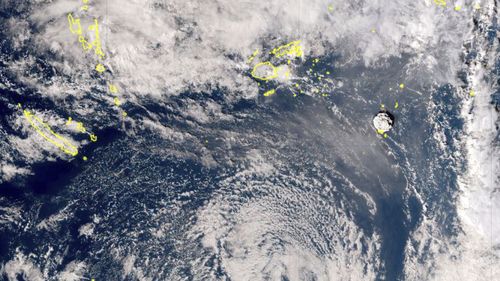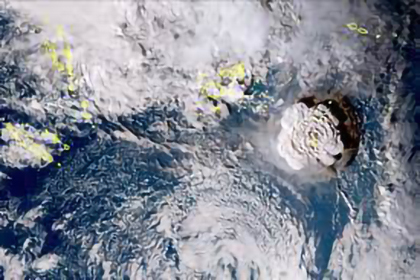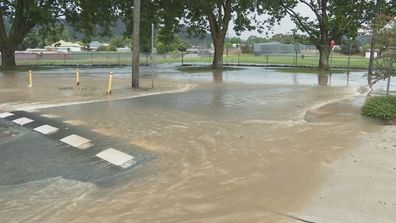Tonga volcano: Tsunami warning for Australia, evacuations ordered on Lord Howe Island after underwater eruption
An undersea volcano erupted in spectacular fashion near the Pacific nation of Tonga on Saturday, sending large waves crashing across the shore and people rushing to higher ground.
Tonga’s King Tupou VI was evacuated by a convoy of police and military troops, according local news reports, and tsunami warnings have been issued stretching as far as Australia, including evacuations ordered on Lord Howe Island.
The Bureau of Meteorology (BoM) has issued a tsunami warning for parts of Australia’s east coast including Queensland, New South Wales, Victoria and Tasmania — as well as Lord Howe, Norfolk and Macquarie islands.

Just before midnight, NSW State Emergency Service ordered the evacuation of low-lying parts of Lord Howe Island.
The BoM said there was a “threat of a major land inundation, flooding, dangerous rips, waves and strong ocean currents”.
“People are advised to move to the closest Evacuation Assembly Area: Corner of Anderson Road and Middle Beach Road, if on the northern end of the island, or the Golf Club House Carpark if on the southern end of the island.”
The Hunga Tonga-Hunga Ha’apai volcano near Tonga erupted at 3.10pm AEDT on Saturday. Tsunami waves have already been observed.
“The size of these waves means the threat is for the marine environment for the east coast of Australia, and for land on Lord Howe Island and Norfolk Island; however the situation will be closely monitored and warnings updated as required,” the BoM said.
“People in land warning zones are strongly advised to move 1 kilometre inland or go to high ground at least 10 metres above sea level.”
Evacuations are not necessary for marine warning zones, but people are advised to leave the water and move away from the immediate water’s edge, the bureau said.
“Tsunami waves are more powerful than the same size beach waves. There will be many waves and the first wave may not be the largest.”
In Hawaii, the Pacific Tsunami Warning Centre reported waves slamming ashore from half a meter in Nawiliwili, Kauai, to 80 centimetres in Hanalei.
Tonga feels first effects
There were no immediate reports of injuries or the extent of the damage as communications with the small nation remained problematic.
Video posted to social media showed large waves washing ashore in coastal areas, swirling around homes and buildings.

Powerful waves have been seen hitting the shores of the Pacific nation as satellite footage showed the Hunga-Tonga-Hunga-Ha’apai volcano erupting.
The Matangi Tonga news site reported scientists had observed massive explosions, thunder and lightning near the volcano after it started erupting.
The site said satellite images showed a five-kilometre plume of ash, steam and gas rising into the air to about 20 kilometres.
Satellite images showed a huge eruption, a plume of ash, steam and gas captured from the space rising like a mushroom above the blue Pacific waters.
The US StormWatch account described the eruption as “one of the most violent” ever captured on satellite.
The Tonga Meteorological Services said a tsunami warning was in effect for all of the archipelago, and data from the Pacific Tsunami Warning Centre showed waves of 80 centimetres had been detected.
Authorities in the nearby island nations of Fiji and Samoa also issued warnings, telling people to avoid the shoreline due to strong currents and dangerous waves. The Japan Meteorological Agency said there may be a slight swelling of the water along the Japanese coasts, but it is not expected to cause any damage.



The Islands Business news site reported that a convoy of police and military troops evacuated Tonga’s King Tupou VI from his palace near the shore. He was among the many residents who headed for higher ground.
The explosion of the Hunga Tonga Hunga Ha’apai volcano was the latest in a series of spectacular eruptions.
A Twitter user identified as Dr. Faka’iloatonga Taumoefolau posted video showing waves crashing ashore.
“Can literally hear the volcano eruption, sounds pretty violent,” he wrote, adding in a later post: “Raining ash and tiny pebbles, darkness blanketing the sky.”
Fijian TV reporter Jese Tuisinu said on Twitter at 6.40pm (4.40pm AEDT) that Tonga was “literally dark”, sharing a video that showed people trying to reach safe ground.
Australia, New Zealand on high alert
Australian authorities are keeping an eye on the situation.
“Tonga is part of our Pacific family and our thoughts are with the entire community dealing with the impact of the volcanic eruption and tsunami,” the government said in a statement on Saturday night.
“The Prime Minister and Minister for Foreign Affairs are monitoring the situation and Australia stands ready to provide support to Tonga if requested.
“Initial assessments are still underway and DFAT is working to ensure Australians in Tonga are safe and accounted for.
“Any Australians concerned about people in Tonga should contact DFAT on 1300 555 135 or +61 2 6261 3305.”
An emergency warning has also been issued in Fiji.
In a statement Fiji’s Ministerial Resources Department advised people to stay out of the water and off the shore, particularly residents living in low lying coastal areas.
In New Zealand, officials were warning of storm surges from the eruption.
The National Emergency Management Agency said some parts of New Zealand could expect “strong and unusual currents and unpredictable surges at the shore following a large volcanic eruption.”
New Zealand’s military has also said it was monitoring the situation and remained on standby, ready to help if asked.
The volcano is located about 64 kilometres north of the capital, Nuku’alofa. Back in late 2014 and early 2015, a series of eruptions in the area created a small new island and disrupted international air travel to the Pacific archipelago for several days.
Tonga is home to about 105,000 people.









